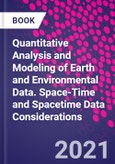Quantitative Analysis and Modeling of Earth and Environmental Data: Space-Time and Spacetime Data Considerations introduces the notion of chronotopologic data analysis that offers a systematic, quantitative analysis of multi-sourced data and provides information about the spatial distribution and temporal dynamics of natural attributes (physical, biological, health, social). It includes models and techniques for handling data that may vary by space and/or time, and aims to improve understanding of the physical laws of change underlying the available numerical datasets, while taking into consideration the in-situ uncertainties and relevant measurement errors (conceptual, technical, computational). It considers the synthesis of scientific theory-based methods (stochastic modeling, modern geostatistics) and data-driven techniques (machine learning, artificial neural networks) so that their individual strengths are combined by acting symbiotically and complementing each other.
The notions and methods presented in Quantitative Analysis and Modeling of Earth and Environmental Data: Space-Time and Spacetime Data Considerations cover a wide range of data in various forms and sources, including hard measurements, soft observations, secondary information and auxiliary variables (ground-level measurements, satellite observations, scientific instruments and records, protocols and surveys, empirical models and charts). Including real-world practical applications as well as practice exercises, this book is a comprehensive step-by-step tutorial of theory-based and data-driven techniques that will help students and researchers master data analysis and modeling in earth and environmental sciences (including environmental health and human exposure applications).
Please Note: This is an On Demand product, delivery may take up to 11 working days after payment has been received.
Table of Contents
1. Introduction to Concepts2. Data Classification, Characterization and Collection3. Statistical Modeling4. Geostatistical Modeling5. Variography6. Regional and Chrono-regional Estimators7. Krigology8. Bayesian Maximum Entropy9. Software Tutorials
Appendix1. Probability and Random Variable Theory2. Instructor and Student Resources








